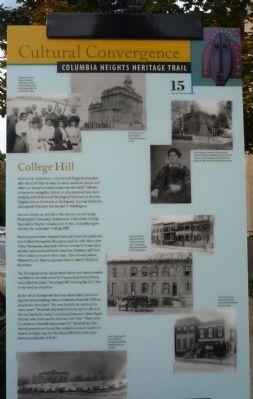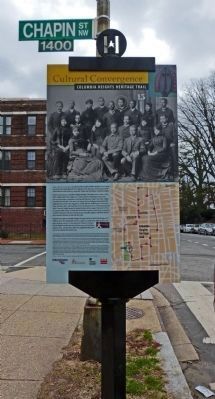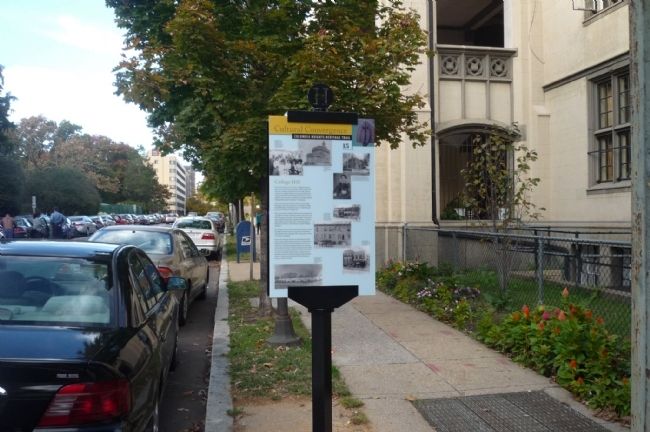Columbia Heights in Northwest Washington in Washington, District of Columbia — The American Northeast (Mid-Atlantic)
College Hill
Cultural Convergence
— Columbia Heights Heritage Trail —
Wayland Seminary opened in Foggy Bottom just after the Civil War to train formerly enslaved people and others as “preachers and teachers for the South” and as missionaries to evangelize Africa. In 1875 it moved here, later merging with Richmond Theological Seminary to become Virginia Union University in Richmond. Among Wayland’s distinguished alumni was Booker T. Washington.
Just two blocks up the hill is the former site of George Washington University’s predecessor, Columbian College. Founded by Baptist missionaries in 1821, Columbian gave the area the nickname “College Hill.”
Some 24 years before Wayland Seminary’s arrival, landowner Col. Gilbert Livingston Thompson and his wife, Mary Ann Tolley Thompson, attended, attended a Prince George’s County slave auction and purchased Emily Saunders Plummer and three of her children to serve them here. After Emancipation, Plummer’s son Henry returned to attend Wayland Seminary.
The Thompson home, which stood where 16th Street is today, was built in the early 1800s by Commodore David Porter, who called his estate “Meridian Hill.” During the Civil War, it was used as a hospital.
By the 1870s, Thompson’s land was subdivided into building lots, and a working-class community of mostly African Americans developed. “Residents depended entirely upon wells and the rain barrel for water,” wrote local historian John Clagett Proctor, who lived nearby after the Civil War. “There were no streets or sidewalks.” Around 1912 the federal government forced the residents out and razed their houses to make way for Meridian Hill Park (later also known as Malcolm X Park).
Erected 2009 by Cultural Tourism DC. (Marker Number 15.)
Topics and series. This historical marker is listed in these topic lists: African Americans • Education • Settlements & Settlers • War, US Civil. In addition, it is included in the Columbia Heights Heritage Trail, and the Historically Black Colleges and Universities series lists. A significant historical year for this entry is 1875.
Location. 38° 55.29′ N, 77° 2.109′ W. Marker is in Northwest Washington in Washington, District of Columbia. It is in Columbia Heights. Marker is at the intersection of 15th Street Northwest and Chapin Street Northwest, on the right when traveling north on 15th Street Northwest. Touch for map. Marker is at or near this postal address: 2331 15th Street Northwest, Washington DC 20009, United States of America. Touch for directions.
Other nearby markers. At least 8 other markers are within walking distance of this marker. An American Meridian (within shouting distance of this marker); Visionary and Park Champion (about 300 feet away, measured in a direct line); Creating the "City Beautiful" (about 300 feet away); Design Challenges (about 300 feet away); Park Designers (about 300 feet away); Art for the People (about 300 feet away); Jeanne d'Arc (about 300 feet away); Mansions, Parks, and People (about 300 feet away). Touch for a list and map of all markers in Northwest Washington.
More about this marker. [Caption, photogaph in upper left:]
Wayland Seminary alumnus Booker T. Washington, center, enjoyed a Negro Business League boat ride in Baltimore, 1908. (Collection of Carolyn Howard French.)
[Caption, photograph in upper center:]
Wayland Seminary’s main building, Coburn Hall, opened in 1875. (Collection of Lynn C. French.)
[Caption, photographs in upper right:]
Emily Saunders Plummer, left, served the Thompson family of Meridian Hill as an enslaved woman. All that remained of the Thompsons’ estate by 1900 was this brick farm house, above. (Smithsonian Anacostia Community Museum. Commission of Fine Arts.)
[Caption, photogaphs in
center right:]
Bakery delivery, below, on 15th St. These houses and those on Euclid St., right, were torn down in 1912 for the [Meridian Hill] park. (Commission of Fine Arts.)
[Caption, photogaph in lower right:]
The corner store at Euclid and 15th Sts. once served the College Hill community. (Commission of Fine Arts.)
[Caption, photogaph in lower left:]
Union army hospital tents spread out alongside Columbian College during the Civil War.
Also see . . . Wayland Seminary. (Submitted on October 26, 2009, by Richard E. Miller of Oxon Hill, Maryland.)
Additional keywords. Reconstruction; Chaplain Henry Vinton Plummer, U.S. Army.
Credits. This page was last revised on January 30, 2023. It was originally submitted on October 26, 2009, by Richard E. Miller of Oxon Hill, Maryland. This page has been viewed 2,399 times since then and 34 times this year. Last updated on March 7, 2019, by Devry Becker Jones of Washington, District of Columbia. Photos: 1. submitted on October 26, 2009, by Richard E. Miller of Oxon Hill, Maryland. 2. submitted on March 16, 2013, by Allen C. Browne of Silver Spring, Maryland. 3. submitted on October 26, 2009, by Richard E. Miller of Oxon Hill, Maryland. • Bill Pfingsten was the editor who published this page.


